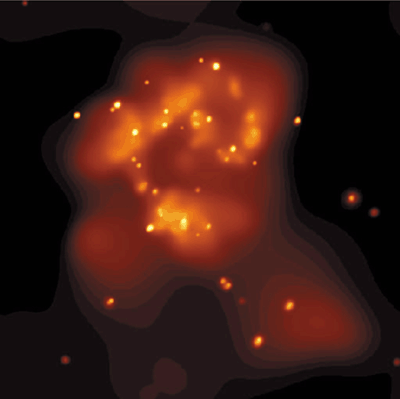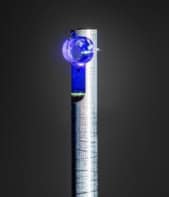Atom: An Odyssey from the Big Bang to Life on Earth...and Beyond
Lawrence Krauss
2001 Little, Brown 320pp £18.99/$26.95hb

In 1984 – the year made famous by George Orwell – I attended a physics conference in the city of Leipzig, East Germany. It was my first visit since I had been a student there 16 years before. As I had imagined, I was constantly followed by officers from the East German secret police, the Stasi. Many years later, after German unification, I had the chance to look at my Stasi files and found in them an accurate, almost minute-by-minute description of my week in the city. In physical terms, the Stasi agents had given an almost complete description of my “world-line” during the conference. There was no need for me to have kept a diary – the Stasi agents had done that for me free of charge. They had found out everything I had done.
To find things out about our universe, all we need is a diary of those components that remain immutable during the changes that constantly occur in the universe, some of which – like exploding supernovae and collapsing stars – can be violent. These immutable objects are, of course, atoms. Imagine taking a single atom of oxygen from a drop of sweat and looking at its entire “diary” since it was created in the aftermath of the big bang. Some 200 years ago, that atom might have been found inside Napolean’s mouth. More than 2000 years ago it was perhaps inside the poisoned cup that Socrates was forced to drink. Seven billion years ago it was perhaps inside an exploding star.
Based on our combined knowledge of particle physics, nuclear physics, cosmology, astrophysics, astronomy, chemistry, astrobiology and other fields, modern science allows us to write down just such a diary. One could, for example, ask a dozen experts in these fields to trace back the world-line of our oxygen atom, until it hits the darkness at the very start of the universe. However, this is unnecessary. All we need to do is to ask Lawrence Krauss to do it. Apart from being the author of The Physics of Star Trek and Beyond Star Trek, Krauss is a professional astrophysicist and is therefore well suited to the task.
However, the world-line of a typical oxygen atom in the universe is a complex one, particularly when one takes into account not just supernovae, stars and planets but also the Cambrian revolution, the Permian extinction, the dinosaurs and Homo neanderthalensis. In fact, it is almost a miracle that the Homo sapiens of today – in the form of Lawrence Krauss – can track down the odyssey of an individual oxygen atom, which requires a great deal of knowledge in the physical sciences, chemistry and biology.
Krauss takes the reader on a journey that started 15 billion years ago – immediately after the big bang, when atoms did not exist. The world then was a bit like hell – a hot plasma of electrons, neutrinos, quarks and other elementary particles. The author then paints a picture of how matter evolved during the first moments of the universe. Readers who are not particle physicists should, however, be prepared for a rocky road. New notions and concepts are introduced at almost relativistic speeds; a few sentences about quarks and the Higgs field are barely enough to clarify these terms.
The book’s foray into particle physics is over when three quarks meet to form a proton or a neutron. We are now in the era of nuclear physics as subatomic particles such as deuterons and helium nuclei are formed. Nuclear physicists, astrophysicists and astronomers are in for a great time in this part of the book, as Krauss enjoys describing primordial nuclear synthesis, the dynamics of supernova explosions and the formation of elements in stars. It is sobering to recall that we are all children of the stars and that the atoms in our bones were formed billions of years ago in violent star explosions.
Our oxygen atom finally comes to some sort of rest in a relatively small planet in the outer reaches of an average galaxy. We then embark on an adventurous trip through the various ages of the Earth. Chemistry and biology now play the major role, as our oxygen atom eventually becomes part of a water molecule in a drop of sweat, dripping from Michael Jordan’s nose during the final game of his basketball career.
Krauss then extrapolates the world-line of his atom into the future, which he does not paint as brightly as many would like. Predictions are, of course, always uncertain, but the laws of physics at least give some constraints on what might happen to the atom – even in the distant future. Despite the fact that Leibniz once declared our world “the best of all possible worlds”, Krauss points out that we presumably live in the worst of all possible universes, in terms of our long-term quality of life. He then embarks on a series of rather fantastic paths in an attempt to make the best out of our present, relying on predictions made by the physicist Freeman Dyson.
Woody Allen once declared: “Eternity is a long time, especially towards the end.” Our oxygen atom presumably will really not stay to the end. Particle physicists have not proved – but firmly believe – that some day a proton inside the nucleus will decay. This would spell the end of the oxygen atom.
Krauss’s diary is written in such detail that readers will sometimes have problems following the main path – there are too many interesting things to the left and right of the road. However, the book is written with a great deal of enthusiasm and looks in many different directions, giving readers the feeling that they too are taking part in the journey. If only Krauss were wrong and Leibniz were right, and we did indeed live in the best of all possible worlds, then this book is certain to have a bright future.



